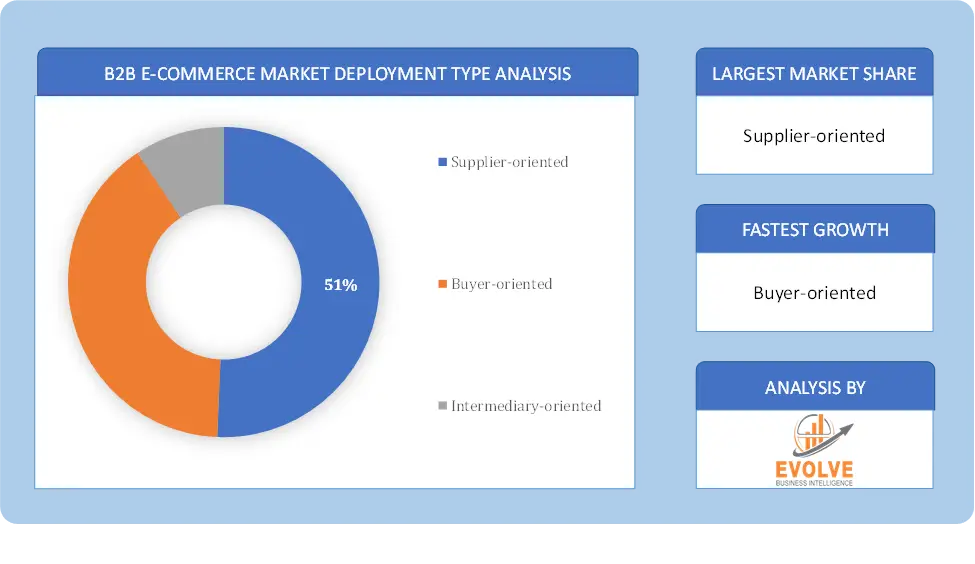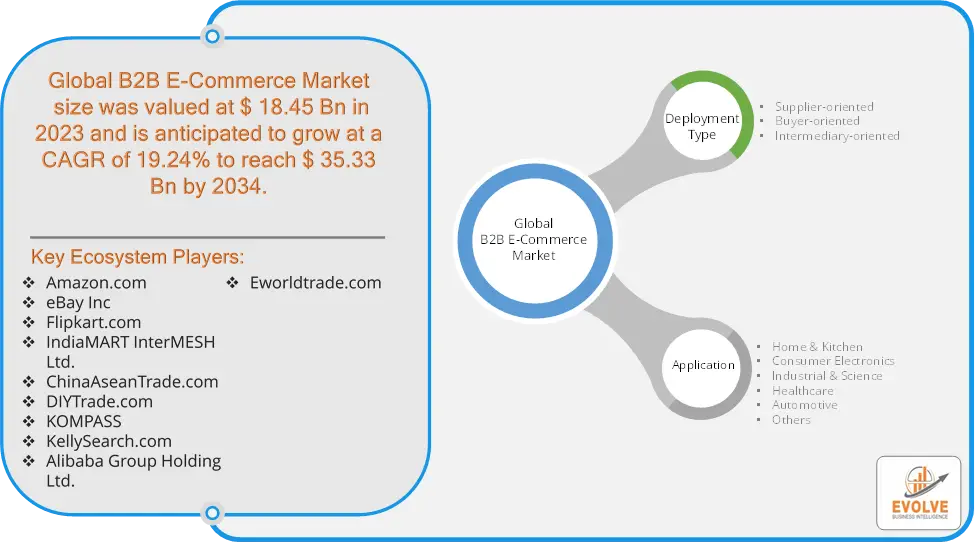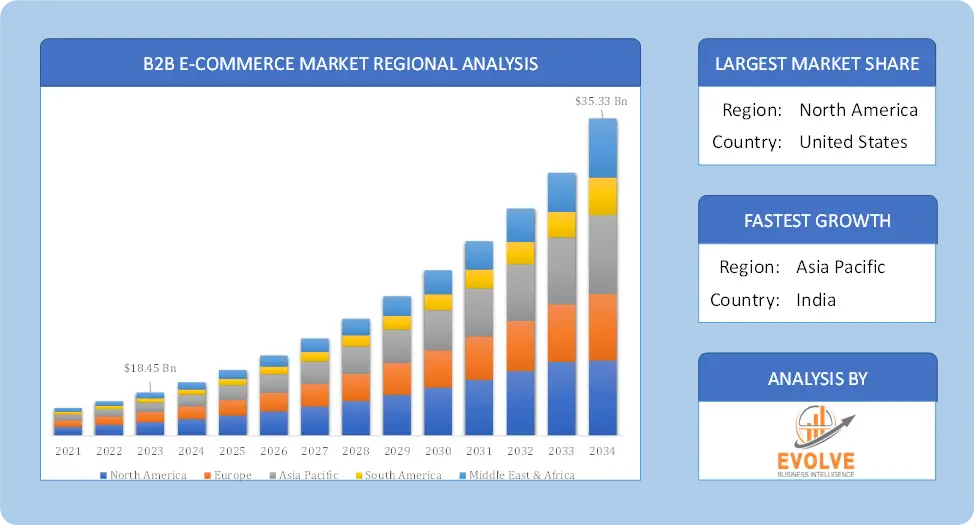B2B E-Commerce Market Analysis and Global Forecast 2023-2033
$ 1,390.00 – $ 5,520.00Price range: $ 1,390.00 through $ 5,520.00
B2B E-Commerce Market Research Report: Information By Deployment Type (Supplier-oriented, Buyer-oriented, Intermediary-oriented), By Application (Home & Kitchen, Consumer Electronics, Industrial & Science, Healthcare, Automotive, Others), and by Region — Forecast till 2033
Page: 109
B2B E-Commerce Market Overview
The B2B E-Commerce Market Size is expected to reach USD 35.33 Billion by 2034. The B2B E-Commerce Market industry size accounted for USD 18.45 Billion in 2023 and is expected to expand at a compound annual growth rate (CAGR) of 19.24% from 2021 to 2034. The B2B (Business-to-Business) e-Commerce market refers to the online platform where transactions and interactions occur between businesses, rather than between businesses and individual consumers. This market involves companies buying and selling goods, services, or information to other businesses through digital channels.
The B2B e-Commerce market aims to streamline business transactions, reduce costs, and improve efficiency through digital channels. The B2B e-commerce market has experienced significant growth in recent years, driven by factors such as increased internet penetration, technological advancements, and changing consumer behavior. As businesses continue to adopt digital technologies, the B2B e-commerce market is expected to play an increasingly important role in the global economy.
Global B2B E-Commerce Market Synopsis
 B2B E-Commerce Market Dynamics
B2B E-Commerce Market Dynamics
The major factors that have impacted the growth of B2B E-Commerce Market are as follows:
Drivers:
Ø Advanced Analytics and Data Insights
B2B e-Commerce platforms provide valuable data and analytics, allowing businesses to make informed decisions, optimize their strategies, and better understand market trends. The increasing use of mobile devices and applications enables businesses to conduct transactions and manage operations on-the-go, contributing to the growth of mobile-optimized B2B e-Commerce platforms. Modern buyers prefer the convenience of online purchasing and are accustomed to the user-friendly experiences offered by B2C e-Commerce, driving demand for similar experiences in the B2B space.
Restraint:
- Perception of Data Security and Privacy Concerns
Ensuring the security and privacy of sensitive business information and transaction data is crucial. Data breaches and cyber threats can pose significant risks and deter businesses from adopting e-Commerce solutions. The initial investment required for setting up and maintaining B2B e-Commerce platforms, including technology, infrastructure, and training, can be substantial, which may be a barrier for smaller businesses.
Opportunity
⮚ Integration with Advanced Technologies
Leveraging technologies such as artificial intelligence (AI), machine learning, and blockchain can enhance B2B e-Commerce platforms by improving automation, personalization, and security, creating new opportunities for innovation. Utilizing advanced analytics and big data can offer businesses valuable insights into customer behaviour, market trends, and operational efficiency, enabling more informed decision-making and targeted strategies. Cloud-based e-Commerce platforms offer scalability, flexibility, and cost-efficiency, enabling businesses to easily adapt to changing market conditions and customer demands.
B2B E-Commerce Market Segment Overview
By Deployment Type
 Based on Deployment Type, the market is segmented based on Supplier-oriented, Buyer-oriented and Intermediary-oriented. The Intermediary-oriented segment dominant the market. The Intermediary-oriented B2B E-commerce involves platforms that act as intermediaries or middlemen, connecting multiple buyers and suppliers. These platforms facilitate transactions, negotiations, and collaboration among businesses. The trend in intermediary-oriented deployment includes the rise of B2B marketplaces that bring together a diverse range of suppliers and buyers on a centralized platform, fostering increased visibility, competition, and streamlined transactions.
Based on Deployment Type, the market is segmented based on Supplier-oriented, Buyer-oriented and Intermediary-oriented. The Intermediary-oriented segment dominant the market. The Intermediary-oriented B2B E-commerce involves platforms that act as intermediaries or middlemen, connecting multiple buyers and suppliers. These platforms facilitate transactions, negotiations, and collaboration among businesses. The trend in intermediary-oriented deployment includes the rise of B2B marketplaces that bring together a diverse range of suppliers and buyers on a centralized platform, fostering increased visibility, competition, and streamlined transactions.
By Application
Based on Application, the market segment has been divided into Home & Kitchen, Consumer Electronics, Industrial & Science, Healthcare, Automotive and Others. In the business-to-business e-commerce market, home & kitchen applications witness a surge in demand. Businesses within this sector leverage online platforms for bulk procurement of kitchenware, appliances, and home essentials. The trend leans towards personalized and sustainable products, and B2B platforms cater to these preferences, offering a diverse range of items. The convenience of digital transactions and the ability to connect with a myriad of suppliers contribute to the flourishing trend of home & kitchen B2B e-commerce.
Global B2B E-Commerce Market Regional Analysis
Based on region, the global B2B E-Commerce Market has been divided into North America, Europe, Asia-Pacific, the Middle East & Africa, and Latin America. North America is projected to dominate the use of the B2B E-Commerce Market followed by the Asia-Pacific and Europe regions.
 B2B E-Commerce North America Market
B2B E-Commerce North America Market
North America holds a dominant position in the B2B E-Commerce Market. The B2B e-Commerce market in North America is highly developed, with a mature infrastructure and widespread adoption of digital technologies. Companies in this region often lead in integrating advanced technologies such as AI, machine learning, and cloud computing into their e-Commerce platforms and many businesses in the region have already adopted digital channels for their B2B transactions.
B2B E-Commerce Asia-Pacific Market
The Asia-Pacific region has indeed emerged as the fastest-growing market for the B2B E-Commerce Market industry. Countries like China and India are key players in the region, with large markets and growing B2B e-Commerce activities. However, there are varying levels of infrastructure and digital adoption across different countries. China is the largest and most dynamic B2B e-commerce market in the region, with a vast number of online marketplaces and a large base of active buyers and sellers. The Asia-Pacific region is experiencing rapid growth in B2B e-Commerce, driven by increasing internet penetration, digital adoption, and economic development.
Competitive Landscape
The global B2B E-Commerce Market is highly competitive, with numerous players offering a wide range of software solutions. The competitive landscape is characterized by the presence of established companies, as well as emerging startups and niche players. To increase their market position and attract a wide consumer base, the businesses are employing various strategies, such as product launches, and strategic alliances.
Prominent Players:
- com
- eBay Inc
- com
- IndiaMART InterMESH Ltd.
- com
- com
- KOMPASS
- com
- Alibaba Group Holding Ltd.
- com
Key Development
In March 2023, Walmart Commerce Technologies and Salesforce collaborated to empower retailers utilizing Salesforce Commerce Cloud. This partnership enables retailers to integrate Walmart’s store fulfillment technologies and local delivery services seamlessly, providing customers with convenient pickup and delivery options, enhancing the overall shopping experience on the Salesforce Commerce Cloud platform.
In Feb 2021, Newegg Commerce, Inc. collaborated with Affirm, Inc., a payment network, to offer customers on Newegg.com flexible payment options like pay-over-time. This partnership enables customers to make purchases with Affirm, dividing payments into manageable installments without hidden or late fees, enhancing the affordability and convenience of transactions on the platform.
Scope of the Report
Global B2B E-Commerce Market, by Deployment Type
- Supplier-oriented
- Buyer-oriented
- Intermediary-oriented.
Global B2B E-Commerce Market, by Application
- Home & Kitchen
- Consumer Electronics
- Industrial & Science
- Healthcare
- Automotive
- Others
Global B2B E-Commerce Market, by Region
- North America
- US
- Canada
- Mexico
- Europe
- UK
- Germany
- France
- Italy
- Spain
- Benelux
- Nordic
- Rest of Europe
- Asia Pacific
- China
- Japan
- South Korea
- Indonesia
- Austalia
- Malaysia
- India
- Rest of Asia Pacific
- South America
- Brazil
- Argentina
- Rest of South America
- Middle East & Africa
- Saudi Arabia
- UAE
- Egypt
- South Africa
- Rest of Middle East & Africa
| Parameters | Indicators |
|---|---|
| Market Size | 2033: $35.33 Billion |
| CAGR | 19.24% CAGR (2023-2033) |
| Base year | 2022 |
| Forecast Period | 2023-2033 |
| Historical Data | 2021 |
| Report Coverage | Revenue Forecast, Competitive Landscape, Growth Factors, and Trends |
| Key Segmentations | Deployment Type, Application |
| Geographies Covered | North America, Europe, Asia-Pacific, Latin America, Middle East, Africa |
| Key Vendors | Amazon.com, eBay Inc, Flipkart.com, IndiaMART InterMESH Ltd., ChinaAseanTrade.com, DIYTrade.com, KOMPASS, KellySearch.com, Alibaba Group Holding Ltd. and Eworldtrade.com |
| Key Market Opportunities | • Integration with Advanced Technologies • Enhanced Data Analytics |
| Key Market Drivers | • Advanced Analytics and Data Insights • Mobile Accessibility |
REPORT CONTENT BRIEF:
- High-level analysis of the current and future B2B E-Commerce Market trends and opportunities
- Detailed analysis of current market drivers, restraining factors, and opportunities in the future
- B2B E-Commerce Market historical market size for the year 2021, and forecast from 2023 to 2033
- B2B E-Commerce Market share analysis at each product level
- Competitor analysis with detailed insight into its product segment, Government & Defense strength, and strategies adopted.
- Identifies key strategies adopted including product launches and developments, mergers and acquisitions, joint ventures, collaborations, and partnerships as well as funding taken and investment done, among others.
- To identify and understand the various factors involved in the global B2B E-Commerce Market affected by the pandemic
- To provide a detailed insight into the major companies operating in the market. The profiling will include the Government & Defense health of the company’s past 2-3 years with segmental and regional revenue breakup, product offering, recent developments, SWOT analysis, and key strategies.
Press Release

Global Pharmaceutical Manufacturing Market to Reach $1.38 Trillion by 2035 with 7.35% CAGR, New Research Shows

The Global Mammography Market Is Estimated To Record a CAGR of Around 10.29% During The Forecast Period

Glue Stick Market to Reach USD 2.35 Billion by 2034

Podiatry Service Market to Reach USD 11.88 Billion by 2034

Microfluidics Technology Market to Reach USD 32.58 Billion by 2034

Ferric Chloride Market to Reach USD 10.65 Billion by 2034

Family Practice EMR Software Market to Reach USD 21.52 Billion by 2034

Electric Hairbrush Market to Reach USD 15.95 Billion by 2034

Daily Bamboo Products Market to Reach USD 143.52 Billion by 2034

Cross-border E-commerce Logistics Market to Reach USD 112.65 Billion by 2034
Frequently Asked Questions (FAQ)
What is the study period of this market?
The study period of the global B2B E-Commerce Market is 2021- 2033
What is the growth rate of the global B2B E-Commerce Market?
The global B2B E-Commerce Market is growing at a CAGR of 19.24% over the next 10 years
Which region has the highest growth rate in the market of B2B E-Commerce Market?
Asia Pacific is expected to register the highest CAGR during 2023-2033
Which region has the largest share of the global B2B E-Commerce Market?
North America holds the largest share in 2022
Who are the key players in the global B2B E-Commerce Market?
Amazon.com, eBay Inc, Flipkart.com, IndiaMART InterMESH Ltd., ChinaAseanTrade.com, DIYTrade.com, KOMPASS, KellySearch.com, Alibaba Group Holding Ltd. and Eworldtrade.com are the major companies operating in the market
Do you offer Post Sale Support?
Yes, we offer 16 hours of analyst support to solve the queries
Do you sell particular sections of a report?
Yes, we provide regional as well as country-level reports. Other than this we also provide a sectional report. Please get in contact with our sales representatives
Table of Content
Chapter 1. Executive Summary Chapter 2. Scope of The Study 2.1. Market Definition 2.2. Scope of The Study 2.2.1. Objectives of Report Chapter 3. Evolve BI Methodology Chapter 4. Market Insights and Trends 4.1. Supply/ Value Chain Analysis 4.2. Porter’s Five Forces Analysis 4.2.1. Threat of New Entrants 4.2.2. Bargaining Power of Buyers 4.2.3. Bargaining Power of Suppliers 4.2.4. Threat of Substitutes 4.2.5. Industry Rivalry 4.3. Impact of COVID-19 on B2B E-Commerce Market 4.3.1. Impact on Market Size 4.3.2. End User Trend, Preferences and Budget Impact 4.3.3. Regulatory Framework/Government Policies 4.3.4. Key Players Strategy to Tackle Negative Impact 4.3.5. Opportunity Window Chapter 5. Market Dynamics 5.1. Introduction 5.2. DRO Analysis 5.2.1. Drivers 5.2.2. Restraints 5.2.3. Opportunities Chapter 6. Global B2B E-Commerce Market, By Deployment Type 6.1. Introduction 6.2. Supplier-oriented 6.3. Buyer-oriented 6.4. Intermediary-oriented Chapter 7. Global B2B E-Commerce Market, By Application 7.1. Introduction 7.2. Home & Kitchen 7.3. Consumer Electronics 7.4. Industrial & Science 7.5. Healthcare 7.6. Automotive 7.7. Others Chapter 8. Global B2B E-Commerce Market, By Region 8.1. Introduction 8.2. North America 8.2.1. Introduction 8.2.2. Driving Factors, Opportunity Analyzed and Key Trends 8.2.3. Market Size and Forecast, By Country, 2020 - 2028 8.2.4. Market Size and Forecast, By Deployment Type, 2020 - 2028 8.2.5. Market Size and Forecast, By Application, 2020 – 2026 8.2.6. US 8.2.6.1. Introduction 8.2.6.2. Driving Factors, Opportunity Analyzed and Key Trends 8.2.6.3. Market Size and Forecast, By Deployment Type, 2020 - 2028 8.2.6.4. Market Size and Forecast, By Application, 2020 - 2028 8.2.7. Canada 8.2.7.1. Introduction 8.2.7.2. Driving Factors, Opportunity Analyzed and Key Trends 8.2.7.3. Market Size and Forecast, By Deployment Type, 2020 - 2028 8.2.7.4. Market Size and Forecast, By Application, 2020 - 2028 8.3. Europe 8.3.1. Introduction 8.3.2. Driving Factors, Opportunity Analyzed and Key Trends 8.3.3. Market Size and Forecast, By Country, 2020 - 2028 8.3.4. Market Size and Forecast, By Deployment Type, 2020 - 2028 8.3.5. Market Size and Forecast, By Application, 2020 – 2026 8.3.6. Germany 8.3.6.1. Introduction 8.3.6.2. Driving Factors, Opportunity Analyzed and Key Trends 8.3.6.3. Market Size and Forecast, By Deployment Type, 2020 - 2028 8.3.6.4. Market Size and Forecast, By Application, 2020 - 2028 8.3.7. France 8.3.7.1. Introduction 8.3.7.2. Driving Factors, Opportunity Analyzed and Key Trends 8.3.7.3. Market Size and Forecast, By Deployment Type, 2020 - 2028 8.3.7.4. Market Size and Forecast, By Application, 2020 - 2028 8.3.8. UK 8.3.8.1. Introduction 8.3.8.2. Driving Factors, Opportunity Analyzed and Key Trends 8.3.8.3. Market Size and Forecast, By Deployment Type, 2020 - 2028 8.3.8.4. Market Size and Forecast, By Application, 2020 - 2028 8.3.9. Italy 8.3.9.1. Introduction 8.3.9.2. Driving Factors, Opportunity Analyzed and Key Trends 8.3.9.3. Market Size and Forecast, By Deployment Type, 2020 - 2028 8.3.9.4. Market Size and Forecast, By Application, 2020 - 2028 8.3.10. Rest of Europe 8.3.10.1. Introduction 8.3.10.2. Driving Factors, Opportunity Analyzed and Key Trends 8.3.10.3. Market Size and Forecast, By Deployment Type, 2020 - 2028 8.3.10.4. Market Size and Forecast, By Application, 2020 - 2028 8.4. Asia-Pacific 8.4.1. Introduction 8.4.2. Driving Factors, Opportunity Analyzed and Key Trends 8.4.3. Market Size and Forecast, By Country, 2020 - 2028 8.4.4. Market Size and Forecast, By Deployment Type, 2020 - 2028 8.4.5. Market Size and Forecast, By Application, 2020 - 2028 8.4.6. China 8.4.6.1. Introduction 8.4.6.2. Driving Factors, Opportunity Analyzed and Key Trends 8.4.6.3. Market Size and Forecast, By Deployment Type, 2020 - 2028 8.4.6.4. Market Size and Forecast, By Application, 2020 - 2028 8.4.7. India 8.4.7.1. Introduction 8.4.7.2. Driving Factors, Opportunity Analyzed and Key Trends 8.4.7.3. Market Size and Forecast, By Deployment Type, 2020 - 2028 8.4.7.4. Market Size and Forecast, By Application, 2020 - 2028 8.4.8. Japan 8.4.8.1. Introduction 8.4.8.2. Driving Factors, Opportunity Analyzed and Key Trends 8.4.8.3. Market Size and Forecast, By Deployment Type, 2020 - 2028 8.4.8.4. Market Size and Forecast, By Application, 2020 - 2028 8.4.9. South Korea 8.4.9.1. Introduction 8.4.9.2. Driving Factors, Opportunity Analyzed and Key Trends 8.4.9.3. Market Size and Forecast, By Deployment Type, 2020 - 2028 8.4.9.4. Market Size and Forecast, By Application, 2020 - 2028 8.4.10. Rest of Asia-Pacific 8.4.10.1. Introduction 8.4.10.2. Driving Factors, Opportunity Analyzed and Key Trends 8.4.10.3. Market Size and Forecast, By Deployment Type, 2020 - 2028 8.4.10.4. Market Size and Forecast, By Application, 2020 - 2028 8.5. Rest of The World (RoW) 8.5.1. Introduction 8.5.2. Driving Factors, Opportunity Analyzed and Key Trends 8.5.3. Market Size and Forecast, By Deployment Type, 2020 - 2028 8.5.4. Market Size and Forecast, By Application, 2020 - 2028 8.5.5. Market Size and Forecast, By Region, 2020 - 2028 8.5.6. South America 8.5.6.1. Introduction 8.5.6.2. Driving Factors, Opportunity Analyzed and Key Trends 8.5.6.3. Market Size and Forecast, By Deployment Type, 2020 - 2028 8.5.6.4. Market Size and Forecast, By Application, 2020 - 2028 8.5.7. Middle East and Africa 8.5.7.1. Introduction 8.5.7.2. Driving Factors, Opportunity Analyzed and Key Trends 8.5.7.3. Market Size and Forecast, By Deployment Type, 2020 - 2028 8.5.7.4. Market Size and Forecast, By Application, 2020 - 2028 Chapter 9. Competitive Landscape 9.1. Introduction 9.2. Vendor Share Analysis, 2020/Key Players Positioning, 2020 Chapter 10. Company Profiles 10.1. Amazon.com 10.1.1. Business Overview 10.1.2. Financial Analysis 10.1.3. Deployment Type Portfolio 10.1.4. Recent Development and Strategies Adopted 10.1.5. SWOT Analysis 10.2. eBay Inc 10.2.1. Business Overview 10.2.2. Financial Analysis 10.2.3. Deployment Type Portfolio 10.2.4. Recent Development and Strategies Adopted 10.2.5. SWOT Analysis 10.3. Flipkart.com 10.3.1. Business Overview 10.3.2. Financial Analysis 10.3.3. Deployment Type Portfolio 10.3.4. Recent Development and Strategies Adopted 10.3.5. SWOT Analysis 10.4. IndiaMART InterMESH Ltd. 10.4.1. Business Overview 10.4.2. Financial Analysis 10.4.3. Deployment Type Portfolio 10.4.4. Recent Development and Strategies Adopted 10.4.5. SWOT Analysis 10.5. ChinaAseanTrade.com 10.5.1. Business Overview 10.5.2. Financial Analysis 10.5.3. Deployment Type Portfolio 10.5.4. Recent Development and Strategies Adopted 10.5.5. SWOT Analysis 10.6. DIYTrade.com 10.6.1. Business Overview 10.6.2. Financial Analysis 10.6.3. Deployment Type Portfolio 10.6.4. Recent Development and Strategies Adopted 10.6.5. SWOT Analysis 10.7. KOMPASS 10.7.1. Business Overview 10.7.2. Financial Analysis 10.7.3. Deployment Type Portfolio 10.7.4. Recent Development and Strategies Adopted 10.7.5. SWOT Analysis 10.8. KellySearch.com 10.8.1. Business Overview 10.8.2. Financial Analysis 10.8.3. Deployment Type Portfolio 10.8.4. Recent Development and Strategies Adopted 10.8.5. SWOT Analysis 10.9. Alibaba Group Holding Ltd. 10.9.1. Business Overview 10.9.2. Financial Analysis 10.9.3. Deployment Type Portfolio 10.9.4. Recent Development and Strategies Adopted 10.9.5. SWOT Analysis 10.10. Eworldtrade.com 10.10.1. Business Overview 10.10.2. Financial Analysis 10.10.3. Deployment Type Portfolio 10.10.4. Recent Development and Strategies Adopted 10.10.5. SWOT Analysis Chapter 11. Key Takeaways
Connect to Analyst
Research Methodology







